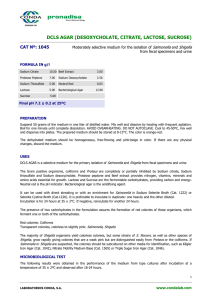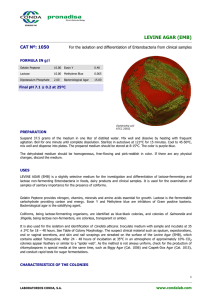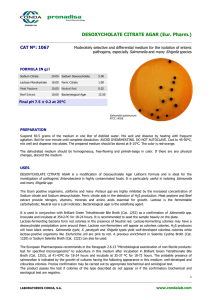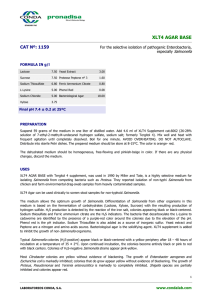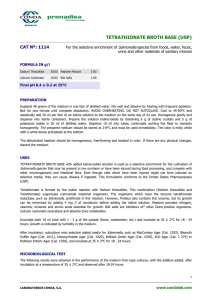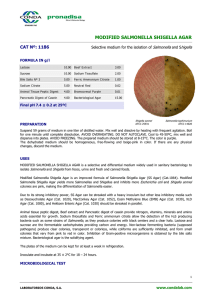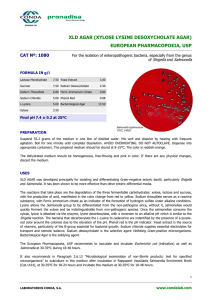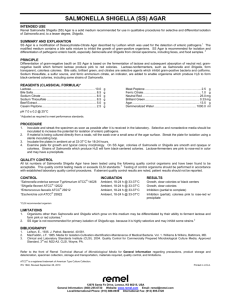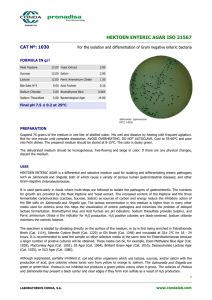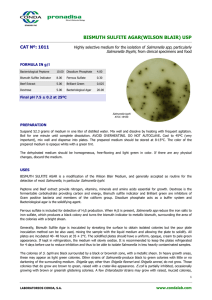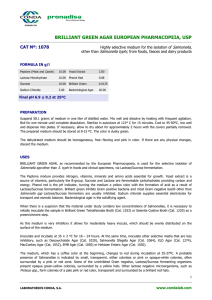SALMONELLA SHIGELLA AGAR (SS AGAR) CAT Nº: 1064 Salmonella Shigella
advertisement
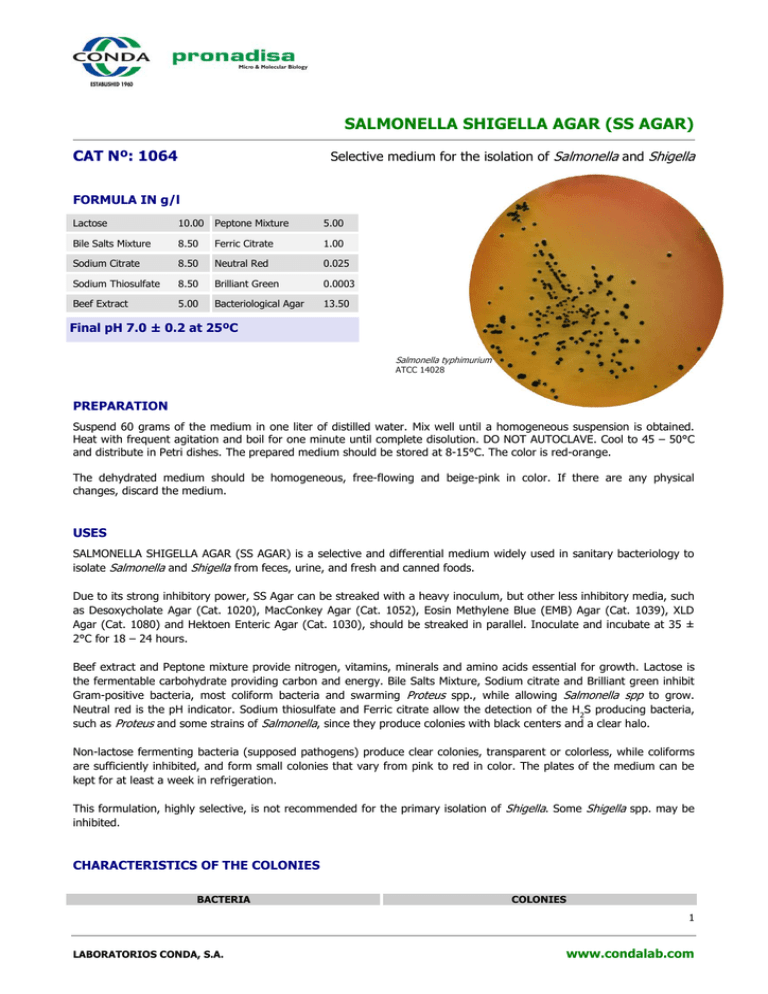
SALMONELLA SHIGELLA AGAR (SS AGAR) CAT Nº: 1064 Selective medium for the isolation of Salmonella and Shigella FORMULA IN g/l Lactose 10.00 Peptone Mixture 5.00 Bile Salts Mixture 8.50 Ferric Citrate 1.00 Sodium Citrate 8.50 Neutral Red 0.025 Sodium Thiosulfate 8.50 Brilliant Green 0.0003 Beef Extract 5.00 Bacteriological Agar 13.50 Final pH 7.0 ± 0.2 at 25ºC Salmonella typhimurium ATCC 14028 PREPARATION Suspend 60 grams of the medium in one liter of distilled water. Mix well until a homogeneous suspension is obtained. Heat with frequent agitation and boil for one minute until complete disolution. DO NOT AUTOCLAVE. Cool to 45 – 50°C and distribute in Petri dishes. The prepared medium should be stored at 8-15°C. The color is red-orange. The dehydrated medium should be homogeneous, free-flowing and beige-pink in color. If there are any physical changes, discard the medium. USES SALMONELLA SHIGELLA AGAR (SS AGAR) is a selective and differential medium widely used in sanitary bacteriology to isolate Salmonella and Shigella from feces, urine, and fresh and canned foods. Due to its strong inhibitory power, SS Agar can be streaked with a heavy inoculum, but other less inhibitory media, such as Desoxycholate Agar (Cat. 1020), MacConkey Agar (Cat. 1052), Eosin Methylene Blue (EMB) Agar (Cat. 1039), XLD Agar (Cat. 1080) and Hektoen Enteric Agar (Cat. 1030), should be streaked in parallel. Inoculate and incubate at 35 ± 2°C for 18 – 24 hours. Beef extract and Peptone mixture provide nitrogen, vitamins, minerals and amino acids essential for growth. Lactose is the fermentable carbohydrate providing carbon and energy. Bile Salts Mixture, Sodium citrate and Brilliant green inhibit Gram-positive bacteria, most coliform bacteria and swarming Proteus spp., while allowing Salmonella spp to grow. Neutral red is the pH indicator. Sodium thiosulfate and Ferric citrate allow the detection of the H2S producing bacteria, such as Proteus and some strains of Salmonella, since they produce colonies with black centers and a clear halo. Non-lactose fermenting bacteria (supposed pathogens) produce clear colonies, transparent or colorless, while coliforms are sufficiently inhibited, and form small colonies that vary from pink to red in color. The plates of the medium can be kept for at least a week in refrigeration. This formulation, highly selective, is not recommended for the primary isolation of Shigella. Some Shigella spp. may be inhibited. CHARACTERISTICS OF THE COLONIES BACTERIA COLONIES 1 LABORATORIOS CONDA, S.A. www.condalab.com Shigella and the majority of salmonellae Escherichia coli Enterobacter, Klebsiella Proteus and some Salmonella Clear, colorless, transparent Small, pink to red Larger than E.coli, mucoid, pale, opaque cream to pink Colorless, transparent, with a black center if H2S is produced MICROBIOLOGICAL TEST The following results were obtained in the performance of the medium from type cultures after anaerobic incubation at a temperature of 35 ± 2°C and observed after 18 - 24 hours. Microorganisms Escherichia coli ATCC 25922 Enterobacter aerogenes ATCC 13048 Salmonella enteriditis ATCC 13076 Salmonella typhi ATCC 6539 Salmonella typhimurium ATCC 14028 Shigella flexneri ATCC 12022 Enterococcus faecalis ATCC 19433 Growth Colony Color Inhibited Partially inhibited Good Good Good Good Inhibited ----Cream-pink Colorless with black center Colorless with black center Colorless with black center Colorless ----- BIBLIOGRAPHY Pub. Health Reports. 65:1075. 1950. Paper Read at Microbiological Congress, 1950. Proc. 22nd Ann. Meet. Northeastern Conf. Lab. Workers in Pullorum Disease Control Burlington, Vermont, June 20-21. 1950. STORAGE 25ºC Once opened keep powdered medium closed to avoid hydration. 2ºC 2 LABORATORIOS CONDA, S.A. www.condalab.com
